Alaska Fish & Wildlife News
April 2015
Gathering Herring Eggs
Subsistence Harvest a Sign of Spring
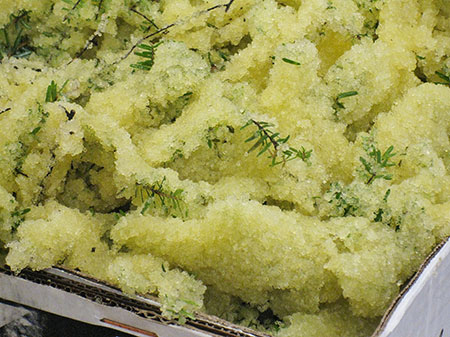
“The herring are here and it’s finally spring.”
This quote from Jessica Gill, resident of Sitka and the tribal herring biologist, pretty well sums up how people in Sitka, and throughout Southeast, feel right now. Herring have returned to Sitka Sound and are preparing to spawn. The commercial fishery for herring sac roe has been occurring over the past week, and here in the Division of Subsistence, we are gearing up for our annual trip to Sitka for the subsistence herring egg harvest. The department works with the Sitka Tribe of Alaska (STA) to monitor the subsistence herring egg harvest. In the next couple of days, I’ll get a phone call that the herring are spawning and we’ll be on the next flight to Sitka.
As part of the collaborative monitoring effort between ADF&G and STA, herring eggs on hemlock branches, on kelp, and on hair seaweed are weighed in different sizes of storage containers to calculate conversion factors for each year’s harvest. This allows us to determine how many pounds of herring eggs are harvested each year. With these conversion factors, we attempt to survey everyone who harvests herring eggs in Sitka Sound to find out how much was harvested, what the harvester did with the eggs, as well as to get a qualitative assessment of the harvest.
The excitement in Sitka at this time of year is palpable. As part of their traditional foods program, STA staff harvests herring eggs each year for distribution to elders and other tribal members, as well as to put up for future parties and events. Word quickly gets around when they are out harvesting eggs and by the time we return to the docks, there’s usually a small crowd of people just waiting to get their first taste of the eggs. For the next few days as we work, people will be stopping by to pick up bags of eggs for themselves, their parents, or other elders in the community. There’s also usually a boat or two down at the docks giving away herring eggs to anyone who stops by.
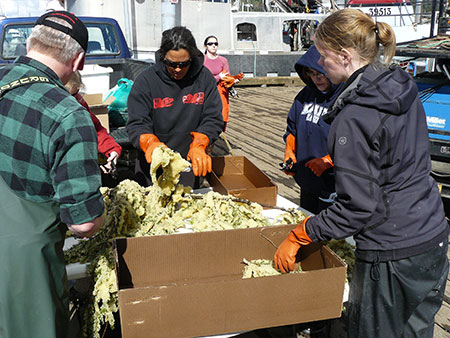
Herring return to Sitka Sound each year to spawn, usually around the end of March, but it could be any time from the end of February to April. You can tell the herring are back by the whales surfacing just off shore, the large groups of seals and sea lions congregating, or the flocks of birds, all feasting upon this small fish. It’s not really known why herring spawn when they do or where they do within Sitka Sound. Some years the spawn seems to happen fast once the herring return, while other years it occurs over many more days.
Eggs can be deposited over many miles of shoreline; since 1980 spawn has been recorded over 40 nautical miles to more than 100 nautical miles of shoreline in Sitka Sound. When the herring spawn, the shorelines of the islands in Sitka Sound turn milky white. Some years the herring were so abundant, people remember when all of Sitka Sound was white with spawn. Stories of herring abundance throughout Southeast Alaska go back a long time. Herring and stories of the harvest of herring eggs are present in the oral history of many Tlingit clans. The presence of herring was a factor in the establishment of at least Sitka, Klawock, Juneau, Wrangell, and the Prince of Wales archipelago.
Many stories tell of the discovery of herring eggs in both Tlingit and Haida traditions. The archaeological record of Southeast Alaska and the Pacific Northwest also reflects an abundance of herring at occupied sites. Narratives written during the time of Russian occupation in Alaska mention Sitka Sound and the large numbers of people who would arrive to harvest herring eggs. More recently, the abundance of herring in Southeast was still noteworthy to many who visited. In the 1880s and 1890s, travel writer Eliza Scidmore traveled multiple times to Alaska by steamer. On one trip, she stopped at Angoon, writing that from, “August into January the waters of Chatham Strait are black with herring.” On a later trip, she recalled that “once in August the mail steamer passed through one school [of herring] for four hours.” Sitka was and is the herring egg capital of Southeast. Smaller spawning events have and do occur around many Southeast communities, but those events were never as long or as certain as the Sitka spawn. For these reasons, the harvest of eggs from Sitka Sound was particularly valued. From Sitka, herring eggs make their way throughout the state and beyond.
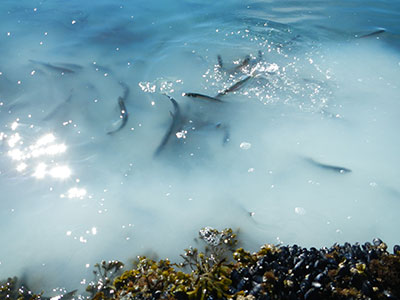
In the current subsistence fishery, the majority of harvesters come from the Sitka area, but there are also boats that travel to the Sound from Hoonah and Angoon, Kake and Hydaburg, even Metlakatla. These boats usually bring back eggs for residents of their communities. Almost everyone who harvests eggs from Sitka Sound shares them. Sometimes it’s with family or neighbors within Sitka, sometimes it’s shipping eggs to family or trading partners elsewhere in the state or the country. From research the department has conducted on this fishery, generally a little less than 10% of the eggs that are harvested are kept for the harvester’s own use. The rest are shared, usually with about half staying in Sitka and half going elsewhere. In just the first degree of sharing that is documented on harvester surveys, eggs have been shared as far away as Barrow, Bethel, Seattle, and Hawaii.
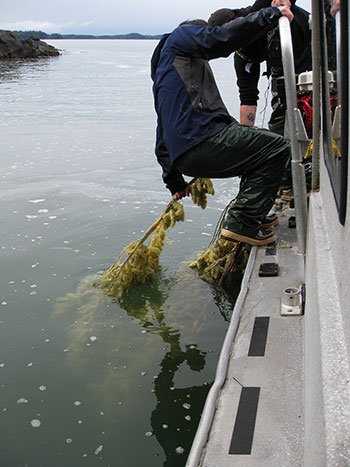
Harvesting herring eggs is a specialized activity and to do it successfully requires a special set of skills and knowledge, not to mention time. Because of this, only a small fraction of the people who use herring eggs actually harvest them. Our studies have shown anywhere from 40 to over 100 households participate in the fishery in any given year, while upwards of 1,000 households use eggs in Sitka alone.
The eggs herring release are sticky, so they adhere to whatever substrate is immediately available, natural or man-made. Harvesters take advantage of this characteristic to gather large quantities of eggs. There are two main methods for harvesting herring eggs in Sitka Sound. One is to harvest naturally occurring seaweed, like macrocystis kelp or hair seaweed, upon which herring eggs have been deposited. The other is to place something in the water, usually freshly cut hemlock trees or branches, for the herring eggs to stick to. The majority of the harvest from Sitka Sound is eggs on branches; last year it accounted for 97% of the harvest by weight while eggs on kelp was 2% and eggs on hair seaweed was 1%. To harvest eggs on branches, just prior to the spawning event a harvester selects trees or branches (usually determined by the size of the boat and whether or not there are hydraulics on board to help pull the set in) and prepare them. Branches are strung together with rocks to anchor them and perhaps a buoy to mark them once set.
The most active harvesters have everything prepared in advance of the spawn and spend time checking on the herring schools and monitoring any spawning activity. Sets can range from just a few branches for a low-level harvester or as much as 60 for an active harvester who supplies eggs to many. Sets are placed where there is active spawning which hopefully will continue for a few days to allow for good deposition on the branches. Once there are enough eggs, the branches get hauled on to the boat and brought back to shore for processing.
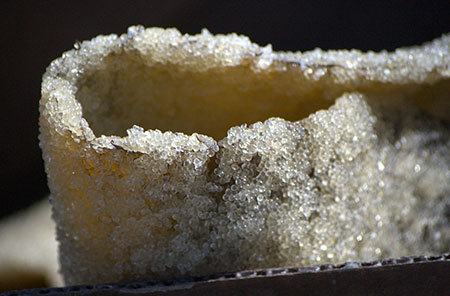
The bigger branches are clipped off and parts that didn’t get good deposition or were contaminated with sand will be discarded. Further processing is determined by the eventual fate of the eggs. Before the widespread use of freezers, eggs were air-dried or salted to preserve them for use throughout the year. The islands throughout Sitka Sound were ideal for drying herring eggs as there were suitable trees and good winds. Nowadays, freezing is the main preservation method.
Eggs that are going to be shipped to friends and family in other parts of the state will often be put in fish boxes. If they’re being given away in town, grocery bags are as likely as anything else to be used. Freezing for personal use may mean putting the eggs into resealable plastic bags or vacuum seal bags. Herring eggs are eaten in a variety of ways. They might be eaten fresh, as soon as they are out of the water. They are often cooked – the branch with the eggs on it is dipped once or twice into boiling water. Cooked too long, the eggs become unpalatable. For herring eggs on kelp, pieces of kelp with herring eggs may be lightly simmered in water or fired in oil. Cooked eggs are eaten with seal oil or hooligan oil. Soy sauce, butter, mayonnaise, vinegar, salt, and pepper are also used.
Lauren Sill is a Subsistence Resource Specialist for the Division of Subsistence and lives in Juneau.
Subscribe to be notified about new issues
Receive a monthly notice about new issues and articles.
